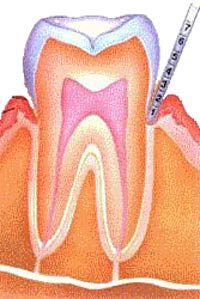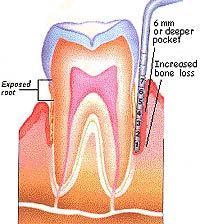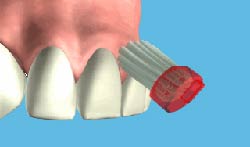| The Treatment
And Prevention Of Gum Disease

Our hygienist dee |
Do you have problems with bleeding gums, bad breath or stained
teeth? Our dental hygienist Dee is trained in all aspects of oral
health care, especially scaling and polishing. She can also provide
the foundation for your preventative treatment by giving home care
advice.
The aim is to make your mouth really healthy and so avoid gum disease.
The hygienists duties also include Fissure sealing teeth. This is
a coating applied to teeth in order to seal and protect them and
is especially useful for children.
Dee is specially trained to show you how to keep your mouth clean
and healthy. Regular visits will help prevent gum disease.
THE STAGES OF PERIODONTAL (GUM) DISEASE:
 |
Health
The gums have a healthy pink colour. Gum line hugs teeth tightly.
No bleeding. |
 |
Gingivitis
Gums bleed easily when you brush or when probed gently during
examination ~ Gums are inflamed and sensitive to touch. Possible
bad breath and bad taste. Gums between teeth may look bluish-red
in color. |
 |
Early Periodontitis
Gums may begin to pull away from the teeth. Bleeding, puffiness
and inflammation more pronounced. Bad breath, bad taste, slight
loss of bone horizontally on X-ray ~ Pockets of 4-5mm between
teeth and gums in one or more areas of the mouth. |
 |
Moderate Periodontitis
Gum boils or abscesses may develop ~ Teeth look longer as gums
begin to recede. Front teeth may begin to drift, showing spaces,
bad breath, bad taste. Both horizontal and angular bone loss
on X-ray. Pockets between teeth and gum range from 4-6mm deep.
Advanced Periodontitis
Teeth may become mobile or loose. Bad breath, bad taste are
constant. Roots may be exposed and are sensitive to hot and
cold. Severe horizontal and angular bone loss on X-ray. Pockets
between teeth and gum now in excess of 6mm deep.
|
The Nature of Gum Disease
Bacteria begin to form and multiply in the mouth shortly after
birth. Almost immediately, our life-long battle against plaque begins.
Plaque is composed mostly of bacteria, in combination with saliva,
food and fluid secreted by the gums. the heaviest concentration
of plaque tends to be at the point where the teeth meet the gums
and between the teeth.
If not removed daily, the bacteria in plaque multiply into colonies.
In time, unremoved plaque hardens into tartar, a tough gritty deposit
that gives new plaque a rough surface to which it can cling. Tartar
can only be removed by a dentist or dental hygienist.
Specific types of bacteria in plaque produce substances toxic to
the gums and bones that hold the teeth in place. If plaque is allowed
to grow, an inflammation of the gum called gingivitis occurs. As
periodontal disease progresses, gums begin to pull away and recede
from the teeth.Pockets of bacteria form and deepen, gradually reaching
and destroying the bone that anchors the teeth. In this advanced
stage known as periodontitis, teeth may be lost without prompt treatment
by a dentists.
You should make it a point to see a dentist for a check up and
professional cleaning at least twice a year, more often if recommended.
The number of essential visits depends on the individual. Some people,
for an instance, form tartar at a faster rate and may need professional
cleaning more often. During a regular visit, plaque and tartar will
be removed from the teeth and the dentist also will check for any
signs that could be indicative of periodontal disease. Regular visits
also give the dentist opportunity to treat various stages of periodontal
disease, which develop with symptoms that are invisible or that
would be missed by an untrained eye.
During checkups an instrument called a periodontal prove is used
to determine if there is any breakdown in the attachment of the
gums to the teeth or early development of pockets between the gums
and teeth. The depth of the pockets is measured in millimeters with
this thin metal instrument. Generally, up to three millimeters is
considered normal. Anything deeper may be an indication that plaque
removal needs to be improved in a particular area of the mouth.
X-rays are also taken to determine the condition of the bone.
Cleaning your teeth and gums
Like most people, you know that having a clean mouth is important.
It makes you feel good about yourself. It gives you fresh breath
and a nicer-looking smile. Since childhood, you've probably heard
that brushing and flossing your teeth daily are necessary for good
dental health. But like many people, you may not be sure why.
Brushing and flossing remove a thin sticky film of bacteria that
grows on your teeth. This sticky film, called plaque, is the main
cause of tooth decay and gum disease. How can bacteria cause so
many problems?
The plaque problem
Many of the foods you eat cause the bacteria in your mouth to produce
acids. Sugared foods, such as candy and cookies, are not the only
culprits. Starches, such as bread, crackers, and cereal, also cause
acids to form. If you snack often, you could be having acid attacks
all day long. After many acid attacks, your teeth may decay.
Plaque also produces substances that irritate the gums, making
them red, tender or bleed easily. After a while, gums may pull away
from the teeth. Pockets form and fill with more bacteria and pus.
If the gums are not treated, the bone around the teeth can be destroyed.
The teeth may become loose or have to be removed. In fact, gum disease
is a main cause of tooth loss in adults.
One way to prevent tooth decay and gum disease is by eating a balanced
diet and limiting the number of between-meal snacks. If you need
a snack, choose nutritious foods such as raw vegetables, plain yogurt,
cheese or a piece of fruit.
Daily oral care
The best way to remove decay-causing plaque is by brushing and
cleaning between your teeth every day. Brushing removes plaque from
the tooth surfaces. Brush your teeth twice a day, with a soft-bristled
brush. The size and shape of your brush should fit your mouth, allowing
you to reach all areas easily. Use a toothpaste that contains fluoride,
which helps protect your teeth from decay.
Cleaning between the teeth with floss or interdental cleaners removes
plaque from between the teeth, areas where the toothbrush can't
reach. It is essential in preventing gum disease.
By taking care of your teeth, eating a balanced diet and visiting
your dentist regularly, you can have healthy teeth and an attractive
smile your entire life. Follow these tips to keep your teeth and
mouth clean.
| Brushing Tips Place
your toothbrush at a 45-degree angle against the gums.
Move the brush back and forth gently in short (toothwide)
strokes.
Brush the outer tooth surfaces, the inner tooth surfaces,
and the chewing surfaces of the teeth.
Use the "toe" of the brush to clean the inside
surfaces of the front teeth, using a gentle up-and-down stroke.
Brush your tongue to remove bacteria and freshen your breath. |

|
| |
| Flossing Facts Break
off about 18 inches of floss and wind most of it around one
of your middle fingers.
Wind the remaining floss around the same finger of the opposite
hand. This finger will take up the floss as it becomes dirty.
Hold the floss tightly between your thumbs and forefingers.
Guide the floss between your teeth using a gentle rubbing
motion. Never snap the floss into the gums.
When the floss reaches the gumline, curve it into a C shape
against one tooth. Gently slide it into the space between
the gum and the tooth.
Hold the floss tightly against the tooth. Gently rub the
side of the tooth, moving the floss away from the gum with
up and down motions.
Repeat this method on the rest of your teeth. Don't forget
the back side of your last tooth.
People who have difficulty handling dental floss may prefer
to use another kind of interdental cleaner. These aids include
special brushes, picks or sticks. If you use interdental cleaners,
ask your dentist about how to use them properly, to avoid
injuring your gums.
|
 |
|


